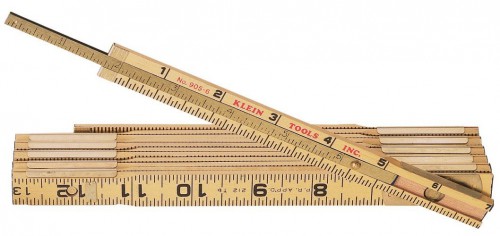Although not so commonly seen nowadays, the carpenter’s folding rule was once a mainstay tool of carpenters and woodworkers. This venerable measuring device essentially consists of multiple small 6″ rulers that are joined together on their ends with pivoting hinges that allow the rule to open and close. When fully extended, a typical folding rule is 6 feet long. When collapsed, it fits into a compact 6″ long bundle that can be tucked away into your pocket or shop apron.
A German tinkerer named Anton Ullrich reportedly invented the folding rule in 1851. Since then, it remained the standard measuring device for tradesmen until the retractable tape measure came along. However, the folding rule has not disappeared entirely from the scene and, in fact, still has a loyal following among masons and old-school carpenters. Masons employ folding rules for spacing courses of bricks using rules that are specially designed for laying out brick courses. The folding rule also comes in handy for taking overhead measurements without having to climb a ladder.
Originally made exclusively from wood, folding rules are now made from aluminum, steel, fiberglass, and wood. The round pivoting hinges that connect the sections are typically made from brass or plastic. Rules come with metric or English markings. For making inside measurements, folding rules often include a sliding extension that butts up against the piece being measured.
It’s fairly simple to use a folding rule. With the rule held in one hand, use the other hand to unfold rule segments until the rule is sufficiently long to take the measurement. It helps to extend the rule to the greatest length that fits between the points being measured, and then slide out the brass extension for the remaining distance. The rule can then be carried to the piece being cut which can be marked directly from the rule without having to remember any numbers. No fuss, no muss.


